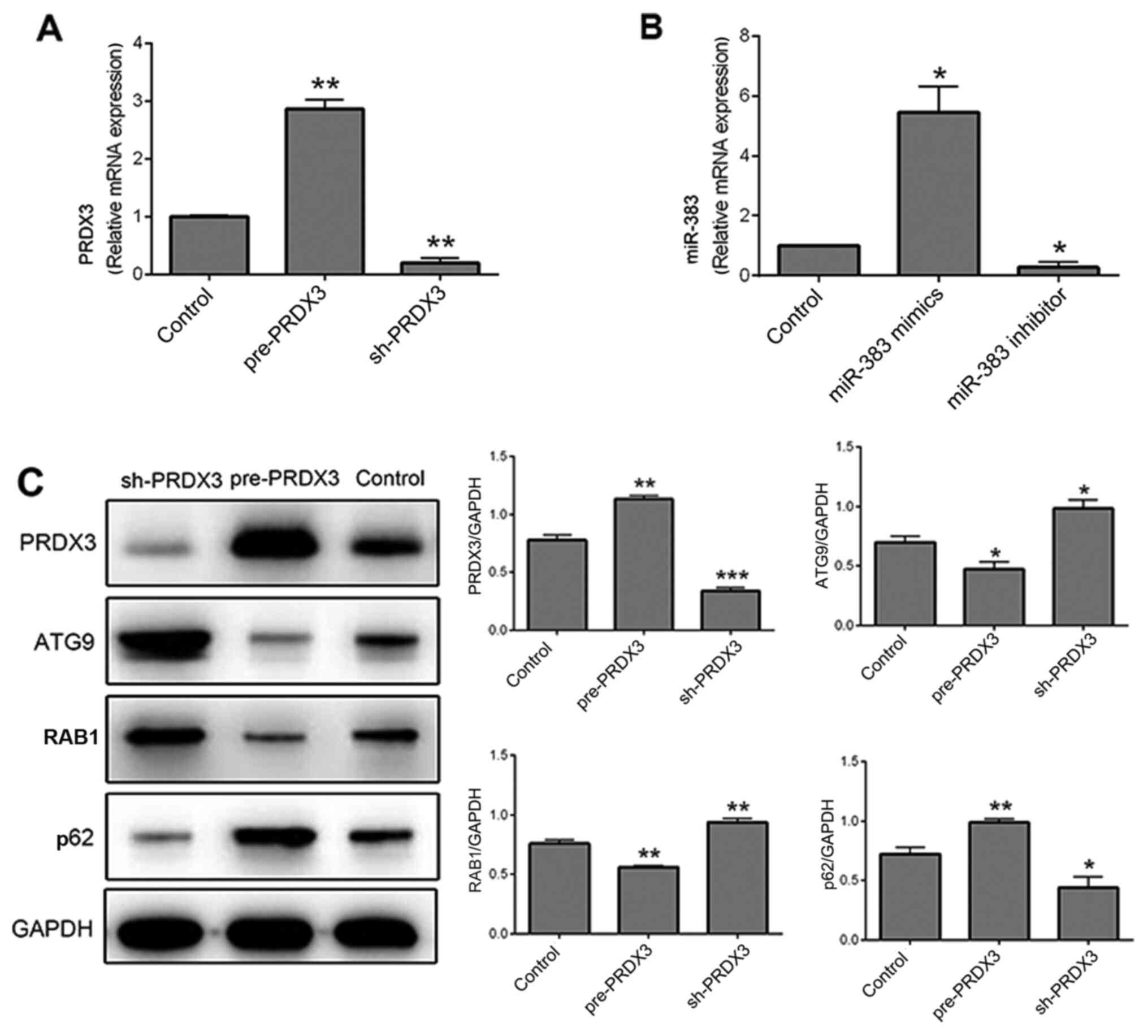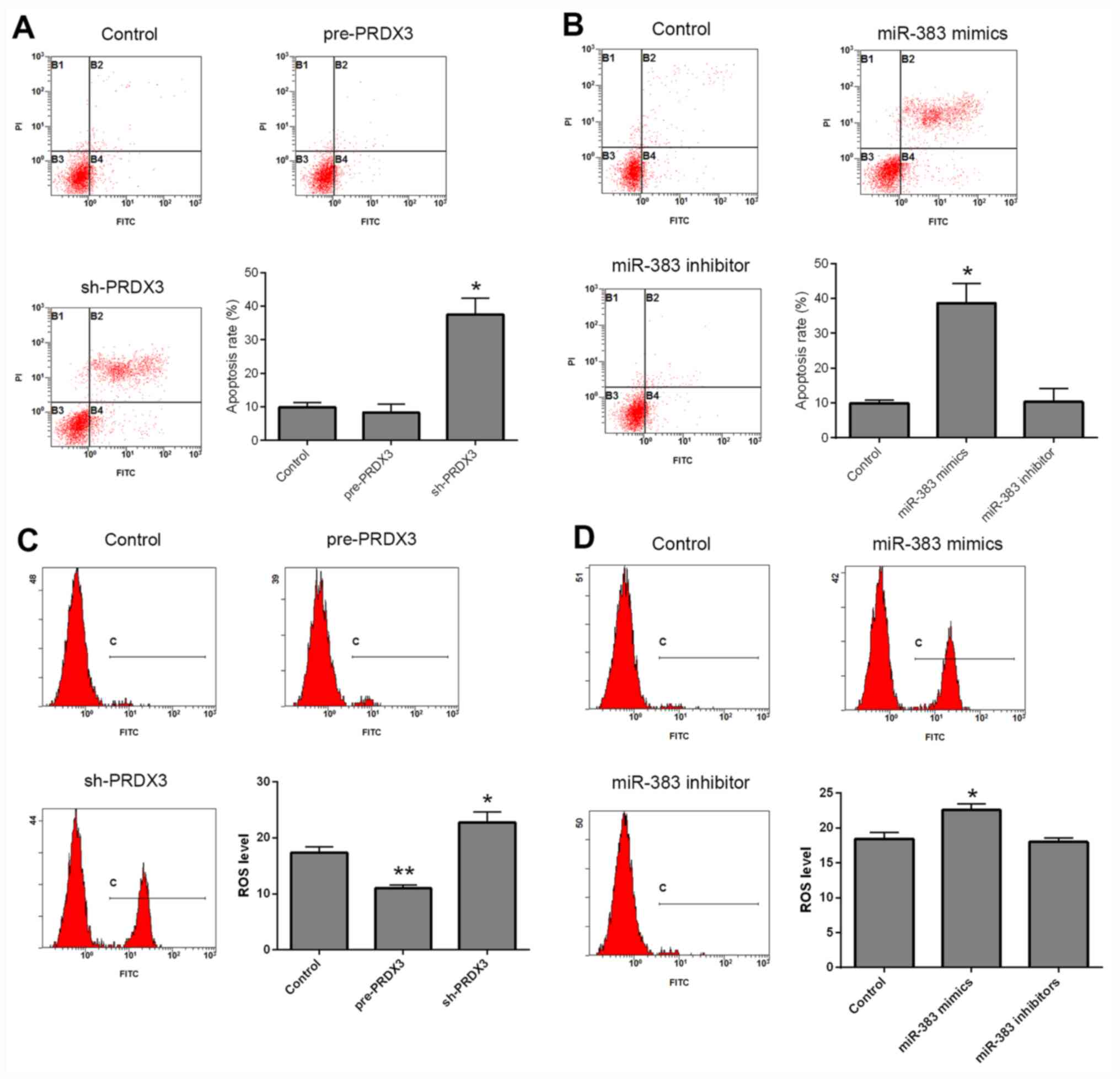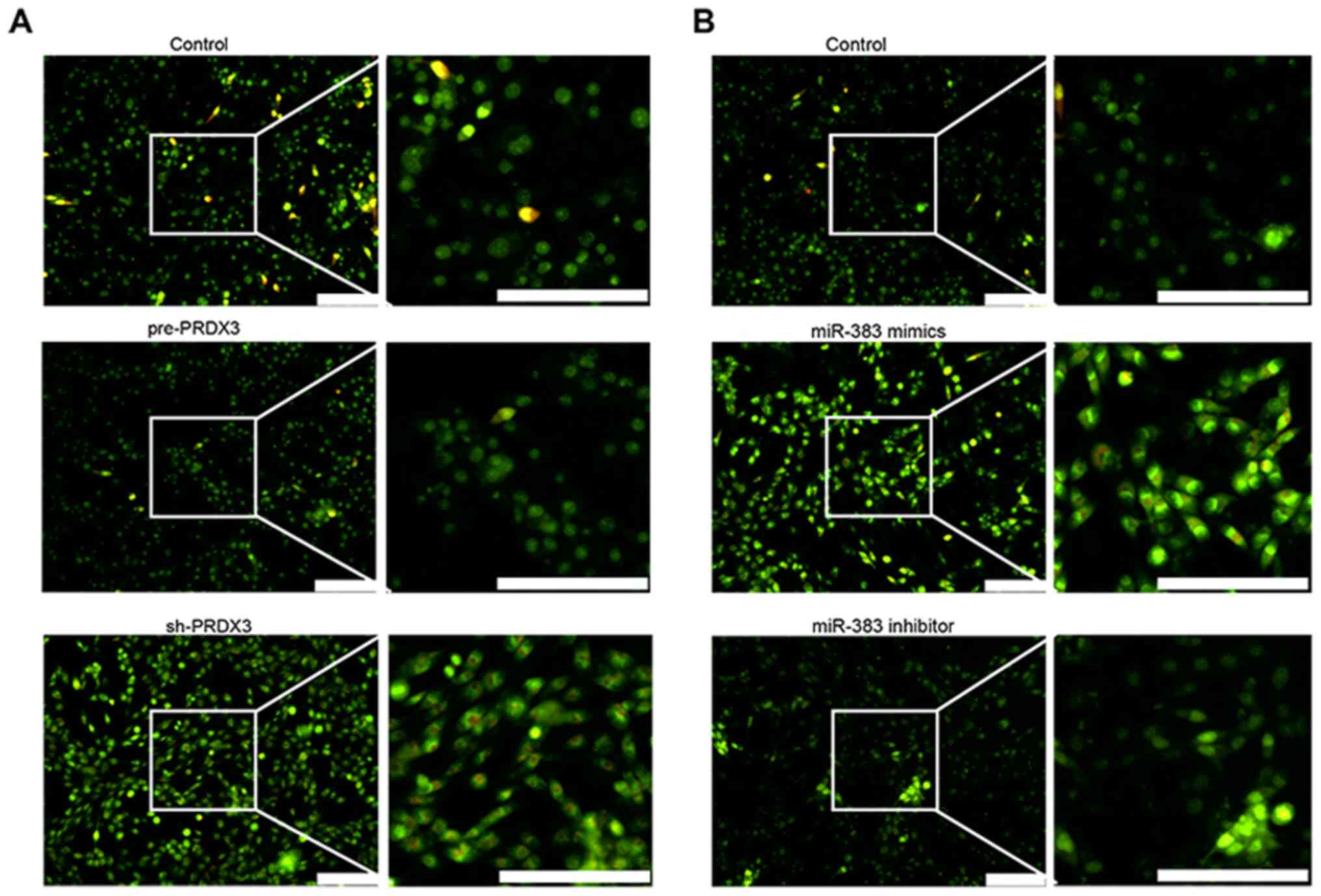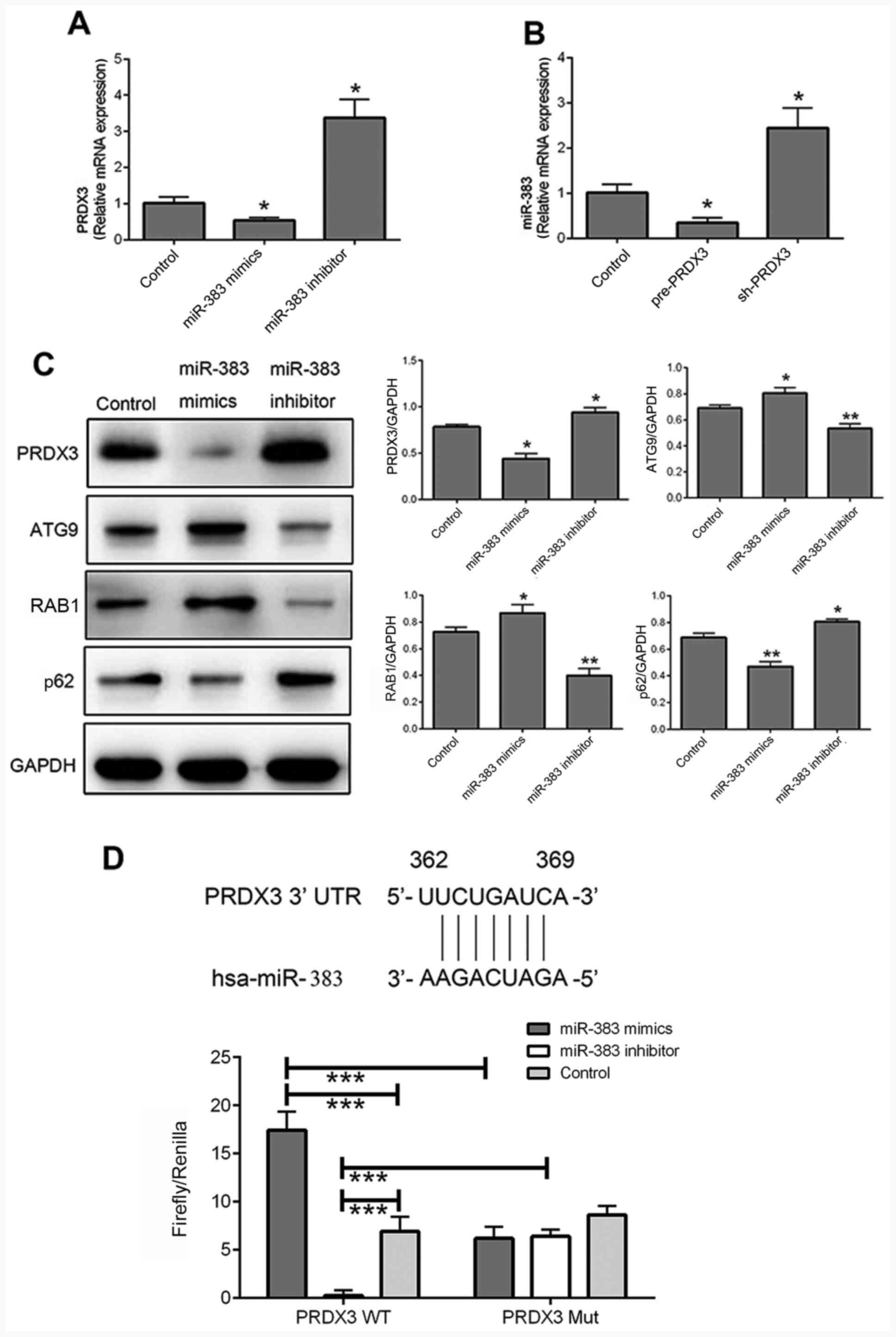|
1
|
Lapointe S, Perry A and Butowski NA:
Primary brain tumours in adults. Lancet. 392:432–446.
2018.PubMed/NCBI View Article : Google Scholar
|
|
2
|
Piccolo SR and Frey LJ: Clinical and
molecular models of glioblastoma multiforme survival. Int J Data
Min Bioinform. 7:245–265. 2013.PubMed/NCBI View Article : Google Scholar
|
|
3
|
Fasolo F, Di Gregoli K, Maegdefessel L and
Johnson JL: Non-coding RNAs in cardiovascular cell biology and
atherosclerosis. Cardiovasc Res. 115:1732–1756. 2019.PubMed/NCBI View Article : Google Scholar
|
|
4
|
Correia de Sousa M, Gjorgjieva M, Dolicka
D, Sobolewski C and Foti M: Deciphering miRNAs' action through
miRNA editing. Int J Mol Sci. 20(6249)2019.PubMed/NCBI View Article : Google Scholar
|
|
5
|
Wang F, Liu W, Jin Y, Wang F and Ma J:
Prenatal and neonatal exposure to perfluorooctane sulfonic acid
results in aberrant changes in miRNA expression profile and levels
in developing rat livers. Environ Toxicol. 30:712–723.
2015.PubMed/NCBI View Article : Google Scholar
|
|
6
|
Iida A, Shinoe T, Baba Y, Mano H and
Watanabe S: Dicer plays essential roles for retinal development by
regulation of survival and differentiation. Invest Ophthalmol Vis
Sci. 52:3008–3017. 2011.PubMed/NCBI View Article : Google Scholar
|
|
7
|
Mohammad SM, Emadodin M and Hamed M:
MiR-21: A key player in glioblastoma pathogenesis. J Cell Biochem.
119:1285–1290. 2018.PubMed/NCBI View Article : Google Scholar
|
|
8
|
Huang TZ, Wan XC, Alvarez AA, James CD,
Song X, Yang Y, Sastry N, Nakano I, Sulman EP, Hu B and Cheng SY:
MIR93 (microRNA-93) regulates tumorigenicity and therapy response
of glioblastoma by targeting autophagy. Autophagy. 15:1100–1111.
2019.PubMed/NCBI View Article : Google Scholar
|
|
9
|
Chen L, Guan H, Gu C, Cao Y, Shao J and
Wang F: miR-383 inhibits hepatocellular carcinoma cell
proliferation via targeting APRIL. Tumour Biol. 37:2497–2507.
2016.PubMed/NCBI View Article : Google Scholar
|
|
10
|
Shang Y, Zang A, Li J, Jia Y, Li X, Zhang
L, Huo R, Yang J, Feng J, Ge K, et al: MicroRNA-383 is a tumor
suppressor and potential prognostic biomarker in human non-small
cell lung caner. Biomed Pharmacother. 83:1175–1181. 2016.PubMed/NCBI View Article : Google Scholar
|
|
11
|
Zhao LN, Wang P, Liu YH, Cai H, Ma J, Liu
LB, Xi Z, Li ZQ, Liu XB and Xue YX: MiR-383 inhibits proliferation,
migration and angiogenesis of glioma-exposed endothelial cells in
vitro via VEGF-mediated FAK and Src signaling pathways. Cell
Signal. 30:142–153. 2017.PubMed/NCBI View Article : Google Scholar
|
|
12
|
Jiang MY, Han ZD, Li W, Yue F, Ye J, Li B,
Cai Z, Lu JM, Dong W, Jiang X, et al: Mitochondrion-associated
protein peroxiredoxin 3 promotes benign prostatic hyperplasia
through autophagy suppression and pyroptosis activation.
Oncotarget. 8:80295–80302. 2017.PubMed/NCBI View Article : Google Scholar
|
|
13
|
Magarin M, Pohl T, Lill A, Schulz H,
Blaschke F, Heuser A, Thierfelder L, Donath S and Drenckhahn JD:
Embryonic cardiomyocytes can orchestrate various cell protective
mechanisms to survive mitochondrial stress. J Mol Cell Cardiol.
97:1–14. 2016.PubMed/NCBI View Article : Google Scholar
|
|
14
|
Song IS, Jeong YJ, Seo YJ, Byun JM, Kim
YN, Jeong DH, Han J, Kim KT and Jang SW: Peroxiredoxin 3 maintains
the survival of endometrial cancer stem cells by regulating
oxidative stress. Oncotarget. 8:92788–92800. 2017.PubMed/NCBI View Article : Google Scholar
|
|
15
|
Li KK, Pang JC, Lau KM, Zhou L, Mao Y,
Wang Y, Poon WS and Ng HK: MiR-383 is downregulated in
medulloblastoma and targets peroxiredoxin 3 (PRDX3). Brain Pathol.
23:413–425. 2013.PubMed/NCBI View Article : Google Scholar
|
|
16
|
Srivastava RK, Li C, Ahmad A, Abrams O,
Gorbatyuk MS, Harrod KS, Wek RC, Afaq F and Athar M: ATF4 regulates
arsenic trioxide-mediated NADPH oxidase, ER-mitochondrial crosstalk
and apoptosis. Arch Biochem Biophys. 609:39–50. 2016.PubMed/NCBI View Article : Google Scholar
|
|
17
|
Chen J, Stimpson SE, Fernandez-Bueno GA
and Mathews CE: Mitochondrial reactive oxygen species and type 1
diabetes. Antioxid Redox Signal. 29:1361–1372. 2018.PubMed/NCBI View Article : Google Scholar
|
|
18
|
Holzerová E and Prokisch H: Mitochondria:
Much ado about nothing? How dangerous is reactive oxygen species
production? Int J Biochem Cell Biol. 63:16–20. 2015.PubMed/NCBI View Article : Google Scholar
|
|
19
|
Kornfeld OS, Hwang S, Disatnik MH, Chen
CH, Qvit N and Mochly-Rosen D: Mitochondrial reactive oxygen
species at the heart of the matter: New therapeutic approaches for
cardiovascular diseases. Circ Res. 116:1783–1799. 2015.PubMed/NCBI View Article : Google Scholar
|
|
20
|
Liu KM, Chuang SM, Long CY, Lee YL, Wang
CC, Lu MC, Lin RJ, Lu JH, Jang MY, Wu WJ, et al: Ketamine-induced
ulcerative cystitis and bladder apoptosis involve oxidative stress
mediated by mitochondria and the endoplasmic reticulum. Am J
Physiol Renal Physiol. 309:F318–F331. 2015.PubMed/NCBI View Article : Google Scholar
|
|
21
|
Christen V, Camenzind M and Fent K: Silica
nanoparticles induce endoplasmic reticulum stress response,
oxidative stress and activate the mitogen-activated protein kinase
(MAPK) signaling pathway. Toxicol Rep. 1:1143–1151. 2014.PubMed/NCBI View Article : Google Scholar
|
|
22
|
Cominacini L, Mozzini C, Garbin U, Pasini
A, Stranieri C, Solani E, Vallerio P, Tinelli IA and Fratta Pasini
A: Endoplasmic reticulum stress and Nrf2 signaling in
cardiovascular diseases. Free Radic Biol Med. 88:233–242.
2015.PubMed/NCBI View Article : Google Scholar
|
|
23
|
Filomeni G, De Zio D and Cecconi F:
Oxidative stress and autophagy: The clash between damage and
metabolic needs. Cell Death Differ. 22:377–388. 2015.PubMed/NCBI View Article : Google Scholar
|
|
24
|
Muriach M, Flores-Bellver M, Romero FJ and
Barcia JM: Diabetes and the brain: Oxidative stress, inflammation,
and autophagy. Oxid Med Cell Longev. 2014(102158)2014.PubMed/NCBI View Article : Google Scholar
|
|
25
|
Livak KJ and Schmittgen TD: Analysis of
relative gene expression data using real-time quantitative PCR and
the 2(-Delta Delta C(T)) method. Methods. 25:402–408.
2001.PubMed/NCBI View Article : Google Scholar
|
|
26
|
Basu A, Banerjee H, Rojas H, Martinez SR,
Roy S, Jia Z, Lilly MB, De León M and Casiano CA: Differential
expression of peroxiredoxins in prostate cancer: Consistent
upregulation of PRDX3 and PRDX4. Prostate. 71:755–765.
2011.PubMed/NCBI View Article : Google Scholar
|
|
27
|
Moreira EF, Kantorow M and Rodriguez IR:
Peroxiredoxin 3 (PDRX3) is highly expressed in the primate retina
especially in blue cones. Exp Eye Res. 86:452–455. 2008.PubMed/NCBI View Article : Google Scholar
|
|
28
|
Whitaker HC, Patel D, Howat WJ, Warren AY,
Kay JD, Sangan T, Marioni JC, Mitchell J, Aldridge S, Luxton HJ, et
al: Peroxiredoxin-3 is overexpressed in prostate cancer and
promotes cancer cell survival by protecting cells from oxidative
stress. Br J Cancer. 109(983)2013.PubMed/NCBI View Article : Google Scholar
|
|
29
|
Lee YJ: Knockout mouse models for
peroxiredoxins. Antioxidants (Basel). 9(182)2020.PubMed/NCBI View Article : Google Scholar
|
|
30
|
Lamb R, Ozsvari B, Lisanti CL, Tanowitz
HB, Howell A, Martinez-Outschoorn UE, Sotgia F and Lisanti MP:
Antibiotics that target mitochondria effectively eradicate cancer
stem cells, across multiple tumor types: Treating cancer like an
infectious disease. Oncotarget. 6:4569–4584. 2015.PubMed/NCBI View Article : Google Scholar
|
|
31
|
Li JZ, Ke Y, Misra HP, Trush MA, Li YR,
Zhu H and Jia Z: Mechanistic studies of cancer cell mitochondria-
and NQO1-mediated redox activation of beta-lapachone, a potentially
novel anticancer agent. Toxicol Appl Pharmacol. 281:285–293.
2014.PubMed/NCBI View Article : Google Scholar
|
|
32
|
Vayalil PK, Oh JY, Zhou F, Diers AR, Smith
MR, Golzarian H, Oliver PG, Smith RA, Murphy MP, Velu SE and Landar
A: A novel class of mitochondria-targeted soft electrophiles
modifies mitochondrial proteins and inhibits mitochondrial
metabolism in breast cancer cells through redox mechanisms. PLoS
One. 10(e0120460)2015.PubMed/NCBI View Article : Google Scholar
|
|
33
|
Hrycay EG and Bandiera SM: Involvement of
cytochrome P450 in reactive oxygen species formation and cancer.
Adv Pharmacol. 74:35–84. 2015.PubMed/NCBI View Article : Google Scholar
|
|
34
|
Doktorova H, Hrabeta J, Khalil MA and
Eckschlager T: Hypoxia-induced chemoresistance in cancer cells: The
role of not only HIF-1. Biomed Pap Med Fac Univ Palacky Olomouc
Czech Repub. 159:166–177. 2015.PubMed/NCBI View Article : Google Scholar
|
|
35
|
Szarek E, Ball ER, Imperiale A, Tsokos M,
Faucz FR, Giubellino A, Moussallieh FM, Namer IJ, Abu-Asab MS,
Pacak K, et al: Carney triad, SDH-deficient tumors, and
Sdhb+/- mice share abnormal mitochondria. Endocr Relat
Cancer. 22:345–352. 2015.PubMed/NCBI View Article : Google Scholar
|
|
36
|
Moloney JN and Cotter TG: ROS signalling
in the biology of cancer. Semin Cell Dev Biol. 80:50–64.
2018.PubMed/NCBI View Article : Google Scholar
|
|
37
|
Pörn-Ares MI, Ares MP and Orrenius S:
Calcium signalling and the regulation of apoptosis. Toxicol In
Vitro. 12:539–543. 1998.PubMed/NCBI View Article : Google Scholar
|
|
38
|
Wu CH, Li J, Li L, Sun J, Fabbri M, Wayne
AS, Seeger RC and Jong AY: Extracellular vesicles derived from
natural killer cells use multiple cytotoxic proteins and killing
mechanisms to target cancer cells. J Extracell Vesicles.
8(1588538)2019.PubMed/NCBI View Article : Google Scholar
|
|
39
|
Song IS, Kim HK, Jeong SH, Lee SR, Kim N,
Rhee BD, Ko KS and Han J: Mitochondrial peroxiredoxin III is a
potential target for cancer therapy. Int J Mol Sci. 12:7163–7185.
2011.PubMed/NCBI View Article : Google Scholar
|
|
40
|
Kudryavtseva AV, Krasnov GS, Dmitriev AA,
Alekseev BY, Kardymon OL, Sadritdinova AF, Fedorova MS, Pokrovsky
AV, Melnikova NV, Kaprin AD, et al: Mitochondrial dysfunction and
oxidative stress in aging and cancer. Oncotarget. 7:44879–44905.
2016.PubMed/NCBI View Article : Google Scholar
|
|
41
|
Zhang YG, Wang L, Kaifu T, Li J, Li X and
Li L: Accelerated decline of physical strength in peroxiredoxin-3
knockout mice. Exp Biol Med (Maywood). 241(1395)2016.PubMed/NCBI View Article : Google Scholar
|
|
42
|
Liu Z, Hu Y, Liang H, Sun Z, Feng S and
Deng H: Silencing PRDX3 inhibits growth and promotes invasion and
extracellular matrix degradation in hepatocellular carcinoma cells.
J Proteome Res. 15:1506–1514. 2016.PubMed/NCBI View Article : Google Scholar
|
|
43
|
Azarbarzin S, Feizi MAH, Safaralizadeh R,
Kazemzadeh M and Fateh A: The value of miR-383, an intronic miRNA,
as a diagnostic and prognostic biomarker in intestinal-type gastric
cancer. Biochem Genet. 55:244–252. 2017.PubMed/NCBI View Article : Google Scholar
|
|
44
|
Xu Z, Zeng X, Tian D, Xu H, Cai Q, Wang J
and Chen Q: MicroRNA-383 inhibits anchorage-independent growth and
induces cell cycle arrest of glioma cells by targeting CCND1.
Biochem Biophys Res Commun. 453:833–838. 2014.PubMed/NCBI View Article : Google Scholar
|
|
45
|
Xu D, Ma P, Gao G, Gui Y, Niu X and Jin B:
MicroRNA-383 expression regulates proliferation, migration,
invasion, and apoptosis in human glioma cells. Tumor Biol.
36:7743–7753. 2015.PubMed/NCBI View Article : Google Scholar
|
|
46
|
Yin M, Wang X, Yao G, Lü M, Liang M, Sun Y
and Sun F: Transactivation of micrornA-320 by microRNA-383
regulates granulosa cell functions by targeting E2F1 and SF-1
proteins. J Biol Chem. 289:18239–18257. 2014.PubMed/NCBI View Article : Google Scholar
|
|
47
|
Fateh A, Hosseinpour Feizi MA,
Safaralizadeh R, Somi MH, Ravanbakhsh R, Shokoohi B, Hashemzadeh S
and Azarbarzin S: Prognostic and predictive roles of microRNA-383
in colorectal cancer. Gastroenterol Insights. 7:1–14. 2016.
|


















